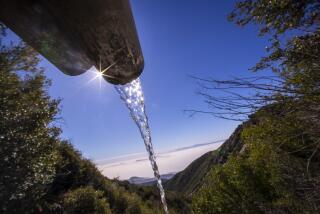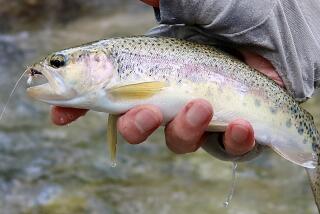Rindge Dam
- Share via
* Your otherwise excellent piece on Rindge Dam and the southern steelhead omits a couple of key pieces of information. (“Removal May be Key to Steelhead Trout Survival,” and “Government Plan Ill-Conceived, Costly,” both March 29).
* Although Ron Rindge clearly has a strong sentimental attachment to Rindge Dam, his family no longer owns it. Malibu Canyon, including the dam, was purchased by the state of California in 1983 and is now part of Malibu Creek State Park.
* There is evidence that steelhead once migrated into the upper Malibu Creek watershed. One old-timer told me that they used to take them out of Lobo Creek (near Westlake Village) with pitchforks in the early part of this century.
* Studies of the southern steelhead show they have unique genetic adaptations, including an adaptation to warmer stream temperatures. These genetic adaptations could help ensure survival for the entire species in the event of global climate changes now being predicted by many experts. Thus survival of the small steelhead population in Malibu Creek could have a significance far beyond the number of fish involved.
I know of no public agency that is “irrationally proposing to spend $10 million to $30 million” to remove Rindge Dam. Congress has appropriated $100,000 to study the Malibu Creek watershed, including the various options available to eliminate or surmount the Rindge Dam barrier. These could include notching the dam, boring a hole in it at stream level or developing some sort of fish ladder. When the study is completed, we will know our options and their cost. We, the public, can then decide how much this unique fishery is worth to us and how much we want to spend to modify our dam to maintain and enhance it.
DAVID M. BROWN
Calabasas
*
* In every accessible drainage that steelhead are found, they populate that whole drainage. To believe that a genetically unique native steelhead population evolved in the first two miles of Malibu Creek is absurd.
The Tapia sewage plant has never been implicated as the main cause of water quality degradation and is believed by some to actually contribute to the steelhead’s survival by adding water to the system during low-flow conditions.
The Entrex Inc. study recommended a fish ladder that was deemed unfeasible because of the inaccessibility of the site for construction and maintenance. Fish ladders do not provide safe passage for smolt returning downstream.
Rindge thinks that “reintroduction” is a solution. You cannot reintroduce a genetically unique strain when it becomes extinct. We only get one shot at saving this precious resource.
As to Rindge’s fantasy about using the dam [for] water impoundment, the fill that reaches the top of the structure would have to be removed. The structure would have to be re-engineered and rebuilt to current standards. [Then] plan on dredging every year so it does not silt up as it did in the past.
As to government’s current interest and action regarding this matter, this is my first experience of “conscientious stewardship of hard-earned taxpayer dollars.”
STEVE CASEY
Agoura Hills






